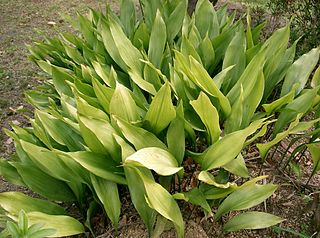
Rosaceae, the rose family, is a medium-sized family of flowering plants that includes 4,828 known species in 91 genera.

Magnolia is a large genus of about 210 to 340 flowering plant species in the subfamily Magnolioideae of the family Magnoliaceae. The natural range of Magnolia species is disjunct, with a main center in east and southeast Asia and a secondary center in eastern North America, Central America, the West Indies, and some species in South America.

The Vitaceae are a family of flowering plants, with 14 genera and around 910 known species, including common plants such as grapevines and Virginia creeper. The family name is derived from the genus Vitis.

Aspidistra is a genus of flowering plants in the family Asparagaceae, subfamily Nolinoideae, native to eastern and southeastern Asia, particularly China and Vietnam. They grow in shade under trees and shrubs. Their leaves arise more or less directly from ground level, where their flowers also appear. The number of species known has increased considerably from the 1980s onwards, with around 100 accepted as of July 2013. Aspidistra elatior is common worldwide as a foliage house plant that is very tolerant of neglect. It and other species can also be grown in shade outside, where they are generally hardy to −5 °C (23 °F).

Aralia, or spikenard, is a genus of the family Araliaceae, consisting of 68 accepted species of deciduous or evergreen trees, shrubs, and rhizomatous herbaceous perennials. The genus is native to Asia and the Americas, with most species occurring in mountain woodlands. Aralia plants vary in size, with some herbaceous species only reaching 50 centimetres (20 in) tall, while some are trees growing to 20 metres (66 ft) tall.

Melicope is a genus of about 240 species of shrubs and trees in the family Rutaceae, occurring from the Hawaiian Islands across the Pacific Ocean to tropical Asia, Australia and New Zealand. Plants in the genus Melicope have simple or trifoliate leaves arranged in opposite pairs, flowers arranged in panicles, with four sepals, four petals and four or eight stamens and fruit composed of up to four follicles.

Rhaphiolepis is a genus of about fifteen species of evergreen shrubs and small trees in the family Rosaceae, native to warm temperate and subtropical East Asia and Southeast Asia, from southern Japan, southern Korea and southern China, south to Thailand and Vietnam. In searching literature it is well to remember that the name commonly is misspelt "Raphiolepsis". The genus is closely related to Eriobotrya (loquats), so closely in fact, that members of the two genera have hybridised with each other; for example the "Coppertone loquat" is a hybrid of Eriobotrya deflexa X Rhaphiolepis indica. The common name hawthorn, originally specifically applied to the related genus Crataegus, now also appears in the common names for some Rhaphiolepis species. For example, Rhaphiolepis indica often is called "Indian hawthorn", and Rhaphiolepis umbellata, "Yeddo hawthorn".

Brassaiopsis is a genus of shrubs in the family Araliaceae. There are about 45 species, distributed in Asia from the Himalaya through China, Vietnam, Thailand to Indonesia.

The genus Cayratia consists of species of vine plants, typical of the tribe Cayratieae. Some of them are useful, and they are found in tropical and subtropical areas of Asia, Africa, Australia, and islands of the Pacific Ocean.
Burretiodendron is a genus of trees. Traditionally included in the family Tiliaceae, it is included in the expanded Malvaceae in the APG and most subsequent systematics. It contains some species formerly in the Pentace. Thus, ParapentaceGagnep. may be a synonym of Burretiodendron rather than Pentace.

Aglaia lawii is a species of tree in the family Meliaceae. As well as the autonym species, there are two subspecies accepted.

Causonis japonica is the type species of vine plant in its genus and is native to Tropical and Subtropical Asia, Australia and the West Pacific. It is used as a traditional Chinese medicine to relieve swelling and heat, and to enhance diuresis and detoxification.
Pterisanthes is a vine plant genus in the subfamily Vitoideae. Its native range is Indochina to W. Malesia including the Philippines. The relationship between Pterisanthes and another genus "Nothocissus" with Ampelocissus has been debated, with the latter now subsumed within Ampelocissus, but with Pterisanthes retained.
Jun Wen is an evolutionary biologist and curator at the Smithsonian's National Museum of Natural History in the Department of Botany and has worked in the Laboratory of Molecular Systematics. She researches the monography, phylogenetics, biogeography, and ethnobotany of the plant families Araliaceae and Vitaceae. She has published over 190 scientific papers.

Causonis is a genus of flowering plants belonging to the family Vitaceae; it is now placed in the tribe Cayratieae.
Hemiboea is a genus of flowering plants belonging to the family Gesneriaceae.
Raphiocarpus is a genus of flowering plants belonging to the family Gesneriaceae.
Pseudocayratia oligocarpa is a species of Asian vine plants in the subfamily Vitoideae. This species, found from central-southern China to Vietnam, was previously placed in the non-monophyletic genus Cayratia, but these genera are not dissimilar and are now placed in the tribe Cayratieae.

The Cayratieae is one of five tribes of vine plants that are now recognised in this subfamily Vitoideae. It contains genera restored or newly erected from species in the previously configured genus Cayratia, which was found not be monophyletic:.
Villosocallerya bonatiana is a species of flowering plant in the family Fabaceae, native to south-central and southeastern mainland China, Laos and Vietnam. It is the sole species in genus Villosocallerya. The species was first described in 1910 as Millettia bonatiana.











